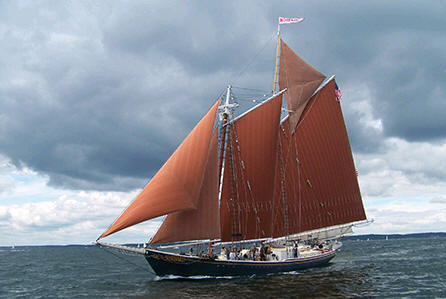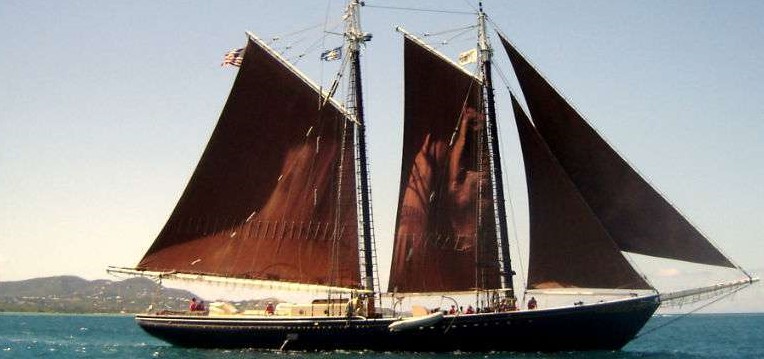CHRISTIANSTED — The familiar brick red sails of the Schooner Roseway are back in St. Croix.
For the twelfth consecutive season, Roseway has returned to Christiansted, where the tall ship will harbor in Gallows Bay through March.
World Ocean School, the non-profit organization that operates Roseway, is currently working with principals of St. Croix’s public schools with the goal of accommodating local public school students hardest hit by the recent storms.
As many schools are closed and the school days are shortened, World Ocean School said that it hopes to provide educational programming aboard Roseway for students during the day when they are not in school.
“World Ocean School is steadfast in its commitment to St. Croix and the U.S. Virgin Islands, and we are committed to this incredible, resilient community that has welcomed and embraced us for the past 12 years,” says Eden Leonard, World Ocean School’s executive director. “While the needs are many, our organization is focused on doing what we do best to support the efforts to rebuild.”
Roseway will resume Sunset Sails from Gallows Bay beginning December 1 at 4 pm, with all proceeds helping to support World Ocean School’s educational programming on board. World Ocean School’s website, www.worldoceanschool.org/get-on-board/sails-voyages, features the full list of upcoming Sunset Sails. Reservations can be made online, or by calling (617) 816-9247.
World Ocean School has served thousands of U.S. Virgin Island students aboard Roseway over the past 12 years. Programs aboard Roseway focus on critical issues for today’s youth including building confidence, providing inspiration for academic or vocational advancement, and helping to instill the value of contribution to community.
History
In the fall of 1920 a Halifax, Nova Scotia, newspaper challenged the fisherman of Gloucester, Massachusetts, to a race between the Halifax fishing schooners and the Gloucester fleet. Therefore many schooners, such as Roseway, built at this time were not strictly designed for fishing but in order to protect American honor in the annual races.
Roseway, 137′ in sparred length, was designed as a fishing yacht by John James and built in 1925 in his family’s shipyard in Essex, Massachusetts. Father and son worked side by side on Roseway, carrying on a long New England history of wooden shipbuilding. She was commissioned by Harold Hathaway of Taunton, Massachusetts, and was named after an acquaintance of Hathaway’s “who always got her way.” Despite her limited fishing history, Roseway set a record of 74 swordfish caught in one day in 1934.
Roseway was built and maintained to an exceedingly high standard, using a special stand of white oak from Hathaway’s property in Taunton. She had varnished rails and stanchions and had a house built for her every winter. She was so well maintained that the coal for the stove was washed before being stored in the bunker. This kind of treatment, which contributed to her longevity, was unheard of in the commercial fishing fleet.
On December 7, 1941, just prior to the attack on Pearl Harbor, the Boston Globe reported the purchase of Roseway by the Boston Pilots Association. In the article, the Pilots described Roseway as “sturdily constructed of oak, the craft is fully capable of withstanding the battering of heavy seas and onslaughts of terrific gales that pilot boats maintaining the lonely vigil off Boston Harbor are called upon to meet.” Clarence Doane, agent for the Boston Pilots, stated that Roseway “approaches as close as possible to specifications of the ideal pilot boat as any vessel. . . .”
In the spring of 1942, Roseway was fitted with a .50-caliber machine gun and assigned to the First Naval District (New England). All lighted navigational aids along the coast were turned off during the war, and it was up to the Pilots and Roseway to guide ships through the minefields and anti-submarine netting protecting the harbor. At the end of the war, the Coast Guard presented a bronze plaque to the pilots in honor of Roseway‘s exemplary wartime service.
She served the pilots well for 32 years and was the last pilot schooner in the United States when she was reluctantly retired in 1973, to be replaced by smaller steel powerboats.
In 1973, Roseway began her transformation to a Windjammer when she was bought by a group of Boston businessmen who rebuilt her below-decks to meet Coast Guard passenger-carrying requirements. In late 1974, she went up for sale and was purchased a year later in Boston by captains Jim Sharp and Orvil Young. In record time, the two captains had added fourteen cabins, creating accommodation for 36 passengers and were under way in the summer of 1975. In 1977, Roseway and the Adventure (built in Essex in 1926) starred in the television remake of Rudyard Kipling’s Captains Courageous, filmed in Camden.
After captains Young and Sharp sold her, she continued in the tourist industry in Camden until the late 90s when she was repossessed by the First National Bank of Damariscotta.
In September 2002, the bank honored a request by the World Ocean School and donated Roseway to be used as a platform for the school. In the early morning hours of November 21, with a crew of two on board, she was harnessed to a tug boat in Rockland harbor and towed to Boothbay Harbor. The following day at the first high tide, she was hauled out of the water on the railway at Sample’s Shipyard where she underwent a complete restoration.
After a two-year restoration of the ship, the school embarked on the maiden voyage to the Great Lakes during the summer of 2005. This voyage was a trial for the ship as well as an opportunity to build support and exposure for the developing School.
In May 2006 Roseway and the World Ocean School relocated to Boston, Massachusetts where program development continued as Roseway was open to the public for the summer season doing day sails and charters.
In November of the same year, Roseway embarked on a passage to St. Croix USVI where she spent the winter serving island students. St. Croix has now become the new winter home port for Roseway. She still summers in the Northeast, primarily in Boston, providing education programs and day sails for the public.
After over 90 years of service, she is one of only six original Grand Banks schooners, and the only schooner specifically designed to beat the Nova Scotians in the international fishing vessel races of the 1920s and 1930s. She is a registered U.S. National Historic Landmark operating in Boston and St. Croix, USVI.




